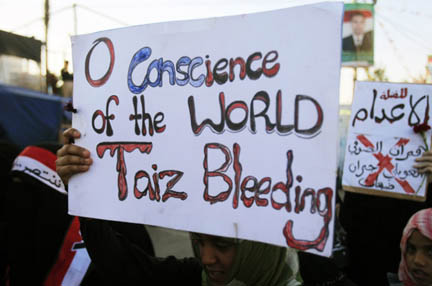
by By Tom Finn, Time, Tuesday, Dec. 13, 2011
Read more: http://www.time.com/time/world/article/0,8599,2102183,00.html#ixzz1gXKFNc14
During the day, Taiz, a mountainous municipality nestled in the basin of Yemen’s rugged central highlands, has the feel of any other Yemeni city. Scrawny teenagers with wheelbarrows filled with oranges weave in and out of the traffic dodging debabs — local six-seater microbuses — and motorbikes as they splutter up and down the city’s steep, dusty alleyways. But once the sun begins to set and the mountains surrounding the bowl of the city darken into jagged silhouettes, the wail of the muezzins soon competes with the ominous thud of explosions.
Taiz is famed for its doctors, lawyers and relative cosmopolitanism, but it was its youth who in February jump-started the movement in Yemen to oust the wily, decades-long ruler, Ali Abdullah Saleh, from power. Inspired by their counterparts in Tunis and Cairo, a group of men and women — most of them students — erected a circle of tents on a dusty boulevard in downtown Taiz and named it Freedom Square. Since then they have spent months braving a barrage of bullets, batons and tear-gas canisters from the security forces, marching through the city’s grubby streets and calling for change. (See photos of Yemen on the brink.)
But in recent weeks the conflict in Taiz has taken on a more deadly twist. With tribal fighters and antigovernment militias entering the fray, the city of 460,000 residents has become a battleground where plainclothes gunmen and government troops hurl mortars and rockets at each other from the mountaintops. A murky and bloody power struggle between the remnants of Saleh’s regime and those seeking to eradicate it has eclipsed the civilian uprising and is threatening to derail a fragile new government of national unity. While the political negotiations go in the north, the battle rages on in Taiz, the outcome of which may determine the fate of Yemen.
Peering out a window of his high-walled residence perched above the city, Hamoud al-Sofi, the city’s governor, claims Taiz is under siege by gunmen from the Islamic opposition party, al-Islah, portions of which he believes are bent on grabbing power for themselves. “Anyone who tells you the opposition in Taiz is peaceful is lying. They are heavily armed, and they want to topple Taiz and make it their Benghazi,” says al-Sofi, referring to the rebel city that the Libyan opposition used to leverage Muammar Gaddafi out of power — violently. He grimaces apologetically as another explosion shakes the city below. “They’re attacking us from all directions with mortars, artillery, antiaircraft guns and RPGs [rocket-propelled grenades]. This is not a peaceful uprising, it’s war.” A lynchpin city straddling north and south, with an international airport and access to the Red Sea, Taiz would certainly make a decent makeshift capital for the opposition, one where they could organize and recruit supporters. (See the Arab Spring as one of the year’s top 10 stories.)
Meanwhile, a U.S.-backed peace accord signed by Saleh on Nov. 23 transferring presidential powers to his deputy in exchange for immunity from prosecution has so far done little to ease anxieties there. Riled by the thought of Saleh escaping trial and with his sons and nephews retaining positions of power in the military, demonstrators have pressed on with a new energy, marching daily in towns and cities across Yemen.
In Taiz, the past week has been brutal. Enraged by the hit-and-run tactics of the rebels, government troops have started raining antiaircraft missiles and rocket-propelled grenades down on the city from their garrisons on the hilltops. Doctors say that since the beginning of December over 15 civilians have been killed, among them a woman and a child crushed by a falling shell. Last week Human Rights Watch declared that 35 unarmed residents of the city had been killed since Oct. 21, when the U.N. issued Security Council Resolution 2014 calling for a cessation of the use of excessive force by the Saleh regime against legitimate peaceful protests.
For the rest of this article, click here.